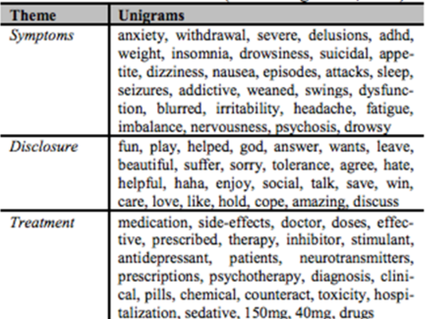|
by Amy Haddlesey  Depression is a mental disorder that is estimated to affect more than 300 million people worldwide. Major Depressive Disorder (MDD) is one of the most commonly diagnosed depressive disorders. MDD is often characterized by having at least 5 of 9 symptoms specified in the Diagnostic and Statistical Manual of Mental Disorders Fifth Edition (DSM-V), with at least one of the symptoms being depressed mood or the loss of interest or pleasure. Other symptoms may include but are not limited to: sleep difficulties, fatigue or loss of energy, reduced ability to concentrate, feelings of worthlessness, and psychomotor agitation or retardation. As a highly prevalent mental illness, it is becoming increasingly important to create new, innovative ways to detect and help depression. In a study done by Microsoft Research, researchers looked into using social media behaviour as a way to infer the behaviours related to depression, with the intention of providing an accessible framework for early detection and diagnosis. The social media platform used in this particular study was Twitter. As a setting for the expression of many significant aspects of behaviour such as a person’s thoughts, mood, activities, and socialization patterns, Twitter provides a wealth of easily accessible knowledge about a person’s emotional condition over time without being intrusive into participants’ lives. In the past, web activity patterns and online behaviour on Facebook have also been studied in relation to mental disorders. For example, researchers have examined trends in Facebook status updates that are associated with depressive symptoms. Using crowdsourcing, the study compiled several hundred Twitter users who participated by completing a CES-D (Centre for Epidemiologic Studies Depression Scale) screening test, Beck Depression Inventory, and an additional survey aimed at gaining depression history and demographic information. A CES-D is a 20-item self-report scale used to measure depressive symptoms. After completing the questionnaires, users could opt in to share Twitter usernames if they had a public profile, under the assumption that their profile could then be mined and analyzed anonymously by computerized programs. Within the study, data or Twitter posts were collected over a yearlong duration from individuals who had given their consent and who had either been diagnosed with depression previously or who had no history of depression. For those who had depression, Twitter data from one year leading up to their diagnosis was collected. For people who did not have depression, Twitter data was collected for the duration of a year ending with the date the survey was completed. In total, 476 users were used within the study. Data from individuals who had depression were used to create a gold standard for the changes in activity on Twitter preceding diagnosis. The behavioural patterns on Twitter of individuals who had depression included: · Posting patterns shifting towards later at night · Decrease in engagement · Higher expression of negative affect · Lower activation · Higher presence of first-person pronouns · Higher use of depression terms · Higher use of words associated with symptoms (Figure 1) · Higher disclosure of feelings and seeking social support · Larger discussion of therapy and treatment Overall, there is a marked increase in certain behaviours and decrease in others before diagnosis that suggests that there may be a shift in behaviour on Twitter leading up to the onset of a depressive episode. By developing this gold standard using data from the depressed group, the study was able to build a statistical classifier that provides an estimate of the risk of depression. In making this prediction, the trend of behavioural change and the degree of the behavioural change the one-year period were both important in identifying behaviour related to depressive symptoms. The study reported that out of their developed models, their best performing model has a 70% accuracy rating for prediction as well as a precision of 0.74. Therefore, the model seems to be able to estimate the risk of depression at an above-chance level, and the model is able to make these estimates relatively consistently. The hopes for this study and moving forward within this area is that the prediction process could aid in identifying behaviour associated with depressive episodes, increase early detection, and lead to having a better support system in place by the time a mental health-related issue presents. Figure 1. Categorization of words into those related to symptoms, disclosure, and treatment.
0 Comments
Your comment will be posted after it is approved.
Leave a Reply. |
Categories |

 RSS Feed
RSS Feed